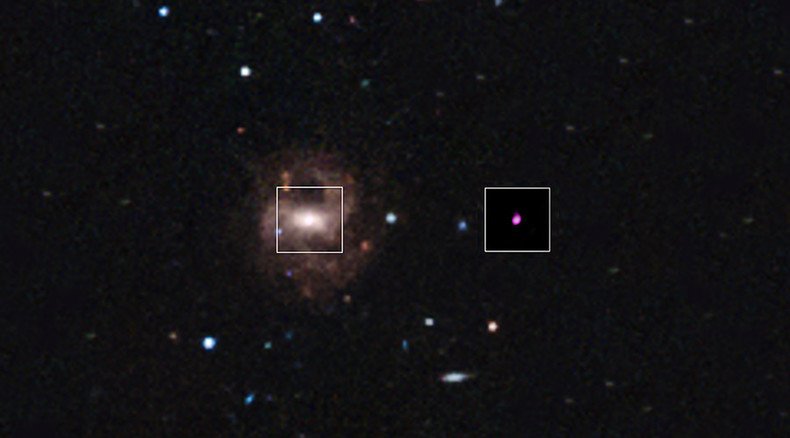NASA discovers ‘smallest supermassive’ black hole ever

Just 50,000 times the mass of the Sun, a new supermassive singularity discovered by NASA is a tiny thing by cosmic standards. Scientists hope studying the black hole will help them learn more about the origins of the universe.
Using the orbiting Chandra X-ray observatory and the 6.5 meter Clay Telescope in Chile, astronomers found the black hole at the center of a dwarf disk galaxy, called RGG 118, some 340 million light years from Earth. The X-rays were produced by the hot gas swirling around the black hole.
“When gas rotates around a black hole, the motion causes the frequency of the light it emits to spread in a characteristic way. The width of this spread is related to the speed of rotation, which in turn is related to the mass of the black hole. By measuring the spread, we found that the black hole in RGG 118 weighs just 50,000 times the mass of the Sun, the smallest supermassive black hole yet reported!” wrote Vivienne Baldassare of the University of Michigan, lead author on the paper about the small supermassive black holes.
Inside look @ our latest release on supermassive black holes from author, Vivienne Baldassare! http://t.co/92QgorzzfSpic.twitter.com/4SavOOQgKi
— Chandra Observatory (@chandraxray) August 12, 2015This is less than half the previous lowest for a black hole observed at the center of a galaxy, according to scientists at the Chandra project. The black hole in RGG 118 is about 100 times less massive than the singularity found at the center of the Milky Way, and about 200,000 less massive than the heaviest black holes found at the centers of other galaxies.
Researchers estimated the mass of the RGG 118 black hole using the visible light data from the Clay Telescope, while the X-ray data from the Chandra observatory was used to figure out the brightness of hot gas swirling towards the singularity. The findings confirmed that the outward push of the radiation pressure from the gas was about 1 percent of the black hole’s inward gravity pull, matching the properties of other observed supermassive black holes. The black hole in RGG 118 also exhibits the same relationship between its mass and the range of velocities of stars in the center of the galaxy as observed elsewhere.
Astronomers hope the discovery and continued observation of RGG 118 will reveal which of the two theories posited about the formation of supermassive black holes is accurate. Under the current models, singularities are formed by the gravitational collapse clouds of cosmic gas ranging from 10,000 to 100,000 times the mass of the Sun, or giant stars about 100 times the mass of the Sun.
Launched in July 1999, the Chandra X-ray Observatory is an orbital telescope specially designed to detect X-ray emission from very hot regions of the universe “such as exploded stars, clusters of galaxies, and matter around black holes,” according to NASA.
Named after Subrahmanyan Chandrasekhar, one of the foremost astrophysicists of the twentieth century, Chandra orbits the Earth at a distance of 139,000 km (86,500 miles). The Smithsonian's astrophysical observatory in Cambridge, Massachusetts hosts the Chandra X-ray Center which operates the satellite, processes the data, and distributes it to scientists around the world for analysis.
Lunch with the Stars! Chandra Adds to Black Hole Birth Announcement, for lunch time reading: http://t.co/Z8uTRQU9A3pic.twitter.com/ufg4z7c4PA
— Chandra Observatory (@chandraxray) August 12, 2015











